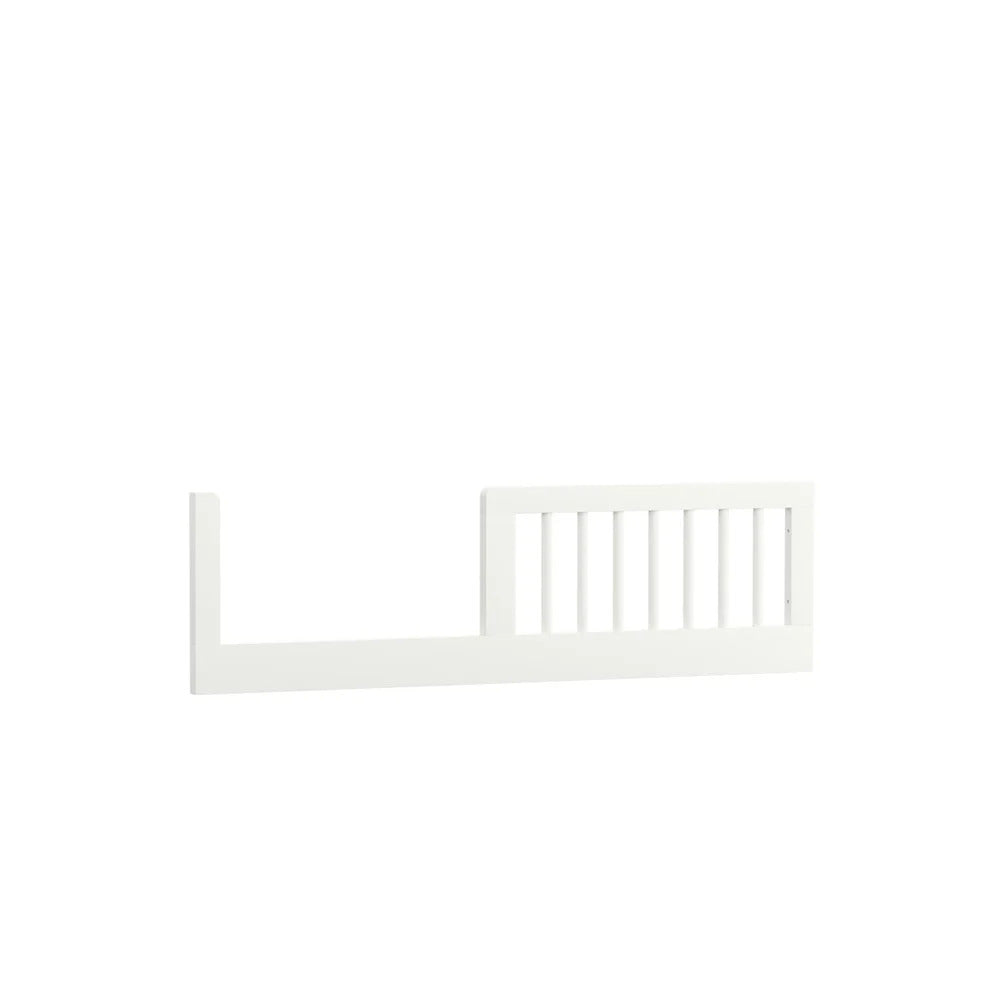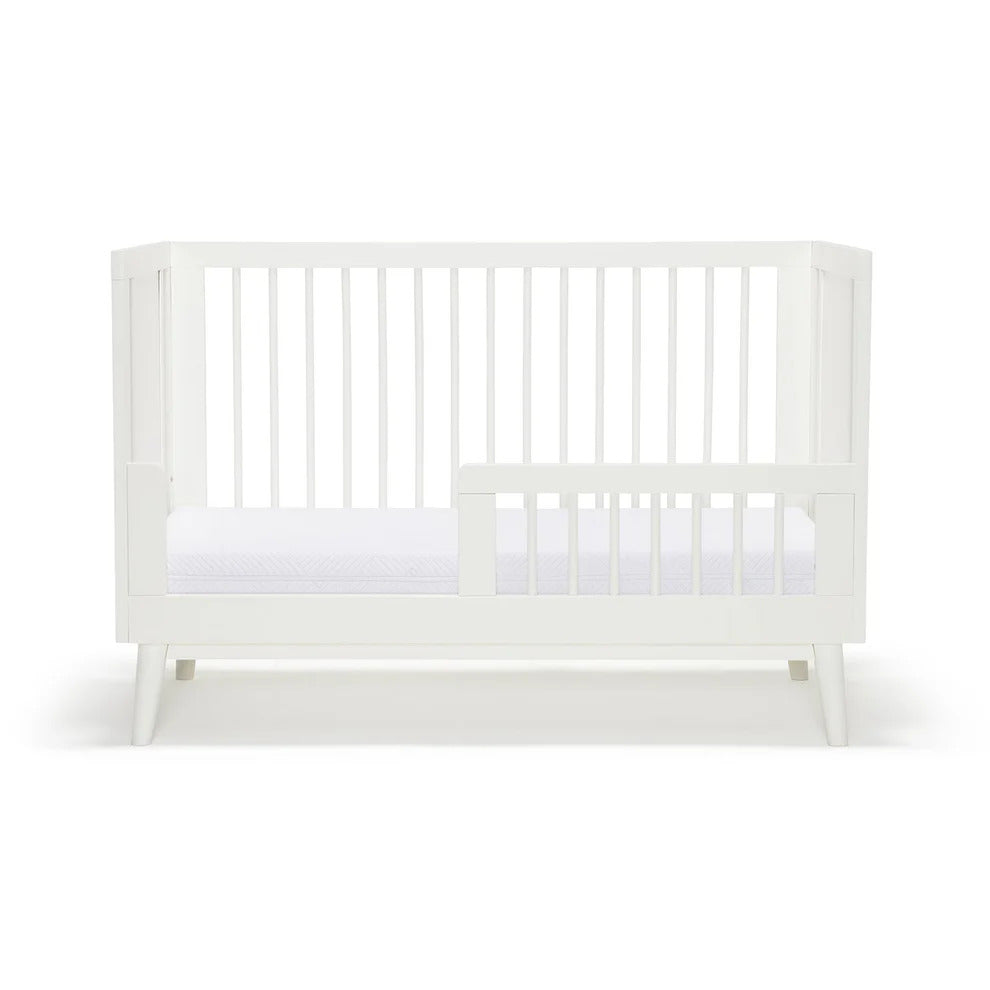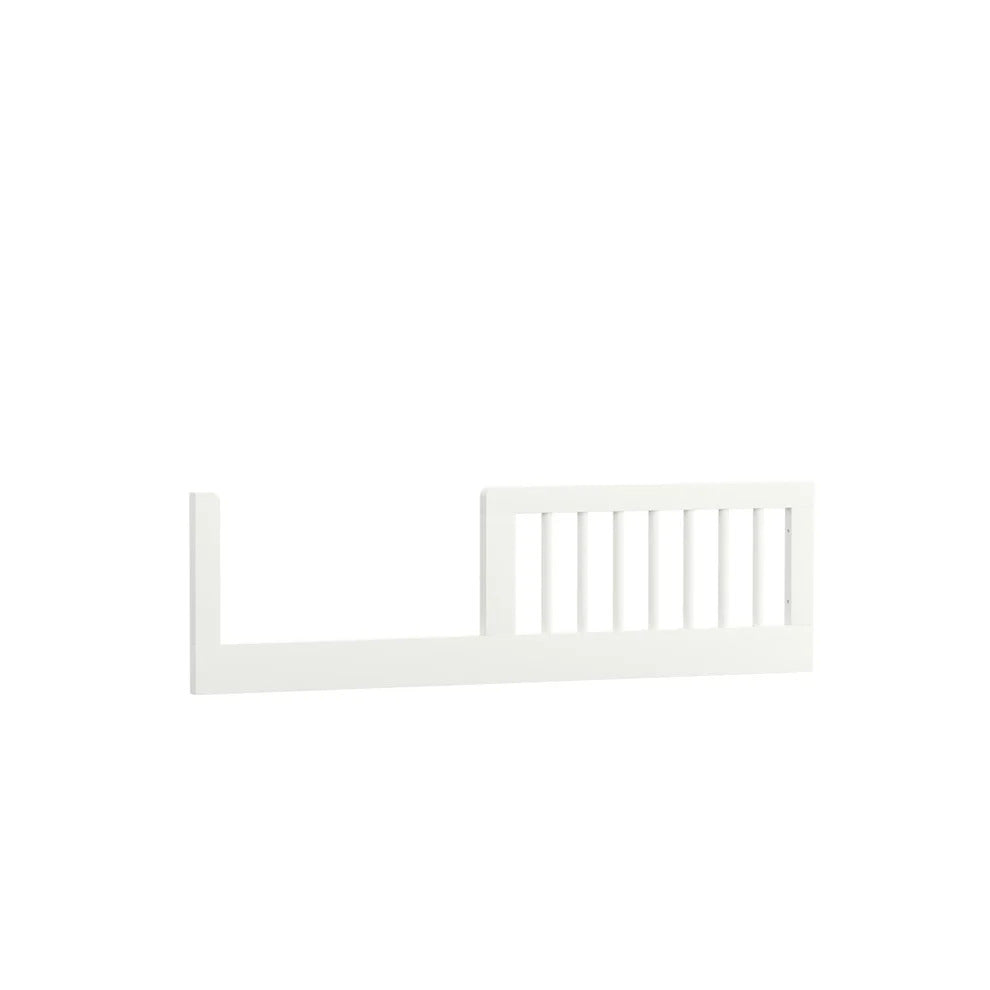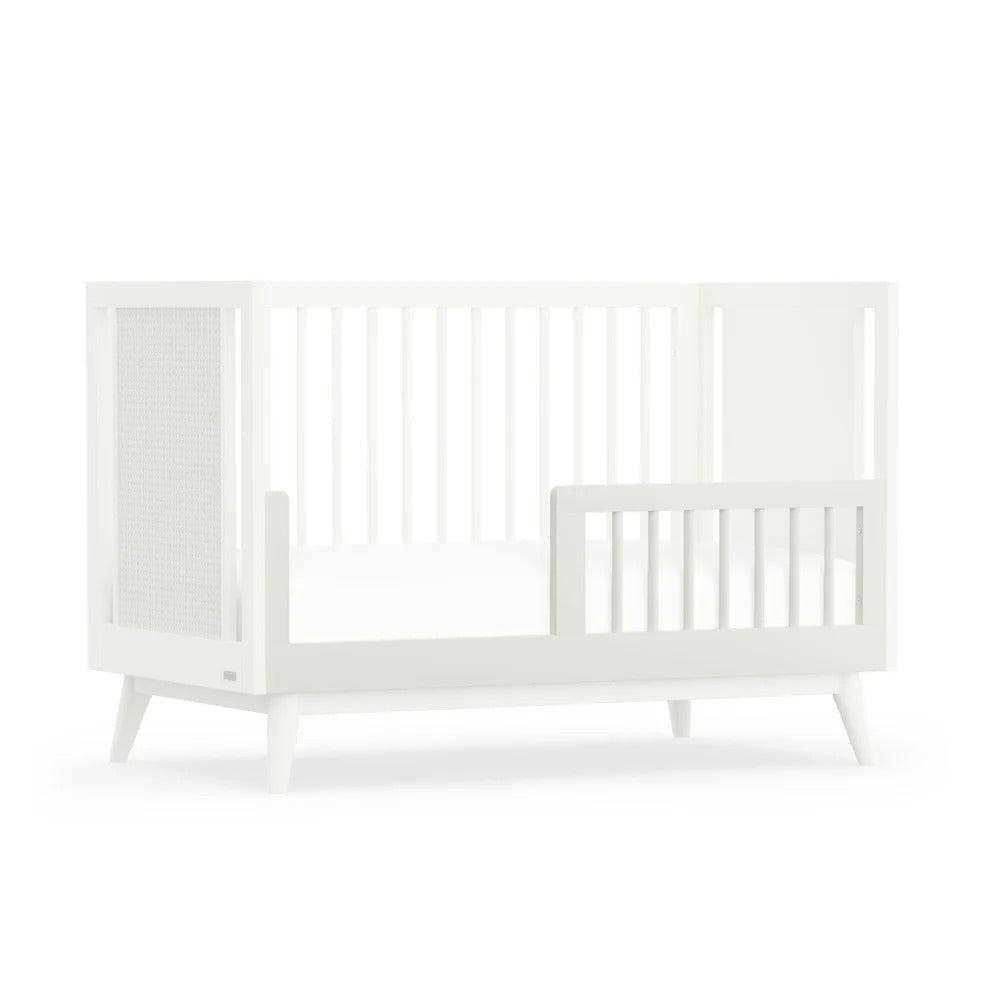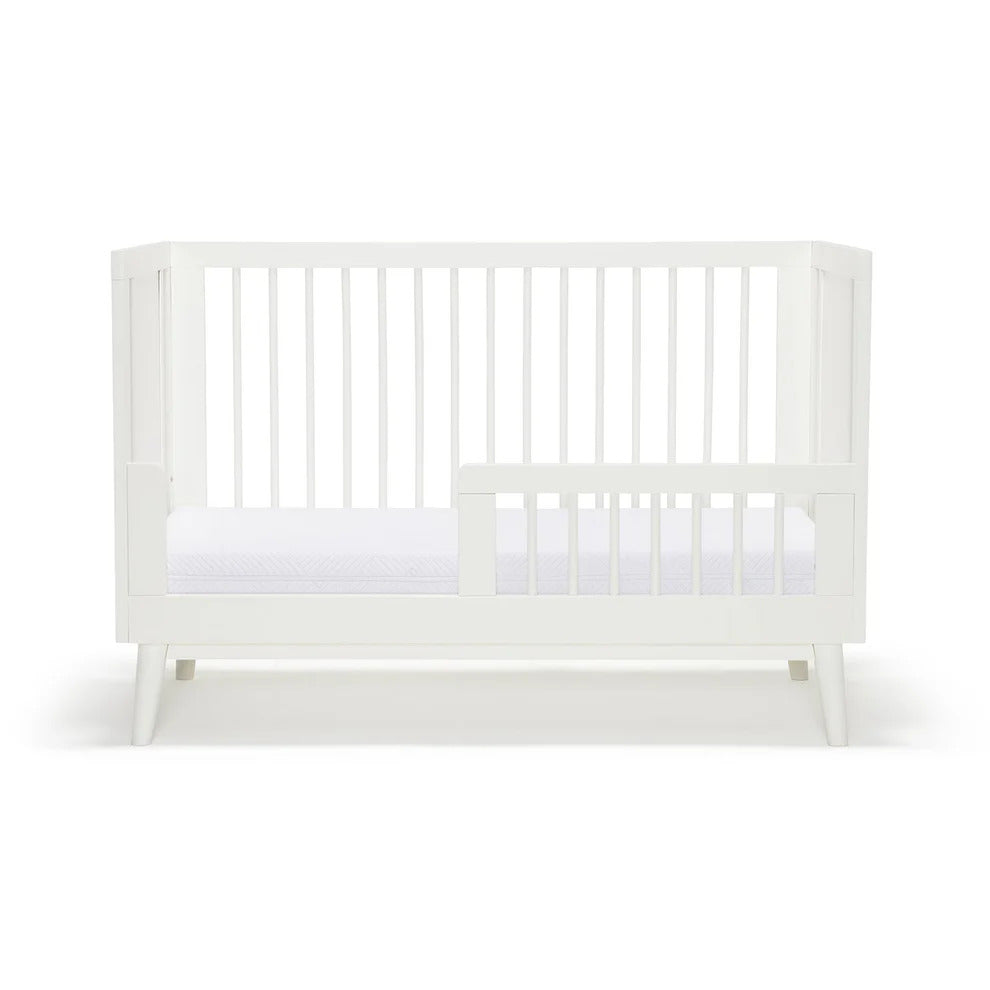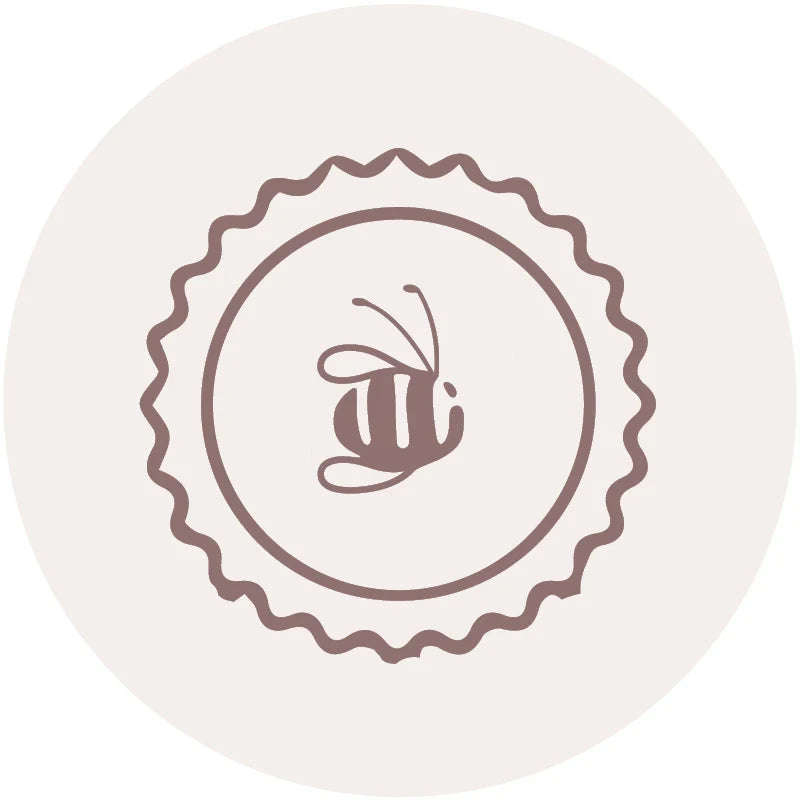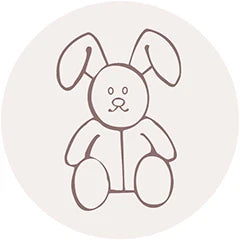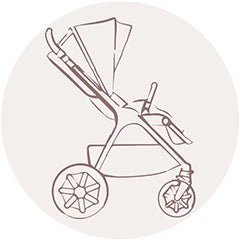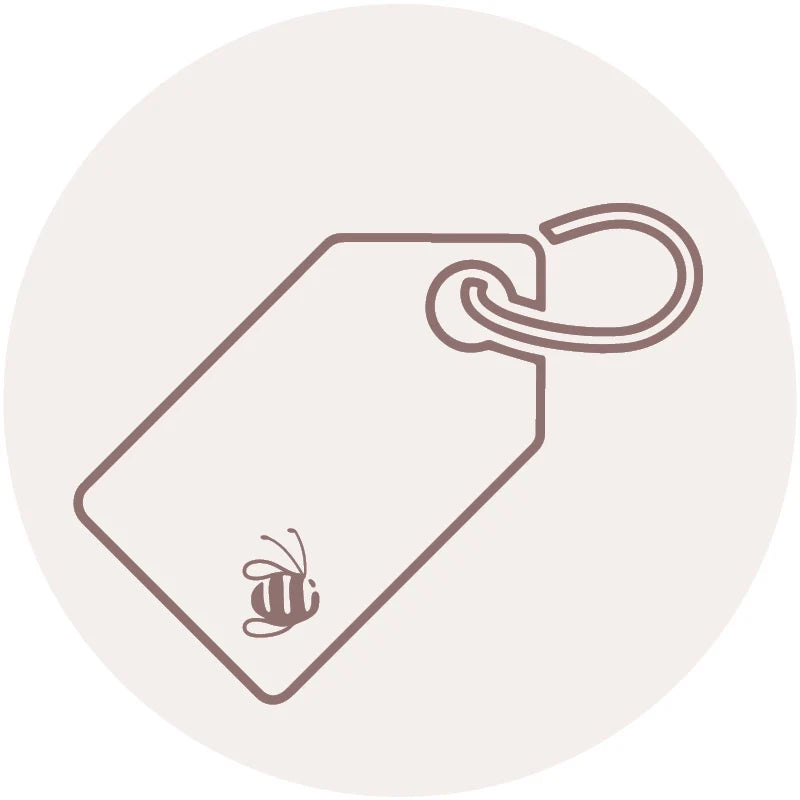Kaya Junior Bedrail
Kaya Junior Bedrail
SKU:ABF-KAJB/WH
Clothing Prem to 18 Months
| Size | Age Guide | Weight | Height |
|---|---|---|---|
| Premature | Premature or Small Newborn | Up to 4Kg | Up to 55cm |
| Newborn | 0-3 months | 4-6Kg | Up to 62cm |
| 3 Month | 3-6 months | 6-8Kg | Up to 68cm |
| 6 Month | 6-12 Month | 8-10Kg | Up to 76cm |
| 12 Month | 12-18 Month | 10-12Kg | Up to 84cm |
| 18 Month | 18-24 Month | 12-14Kg | Up to 92cm |
Clothing 2 to 6 Years
| Size | Age Guide | Height | Chest | Waist | Hip |
|---|---|---|---|---|---|
| 2 Year | 2-3 Years | Up to 100 cm | 56 | 51 | 58 |
| 3 Year | 3-4 Years | Up to 105 cm | 58 | 53 | 60 |
| 4 Year | 4-5 Years | Up to 110 cm | 60 | 55 | 62 |
| 5 Year | 5-6 Years | Up to 115 cm | 62 | 57 | 64 |
| 6 Year | 6-7 Years | Up to 120 cm | 64 | 59 | 66 |
Beanie Size Guide
| Size | Head Circumference | Age Guide |
|---|---|---|
| Premature | 31-35 cm | Premature or Small Newborn |
| Newborn | 35-40 cm | Newborn |
| Small | 40-43 cm | 3-6 Months |
| Medium | 43-47 cm | 6-18 Months |
| Large | 47-52 cm | 18-3 Years |
Sunhat Size Guide
| Size | Head Circumference | Age Guide |
|---|---|---|
| Newborn | 37-40 cm | Newborn |
| Small | 40-43 cm | 3-6 Months |
| Medium | 43-46 cm | 6-12 Months |
| Large | 46-49 cm | 12-24 Months |
| Xtra Large | 49-54 cm | 2-4 Years |
Sleep Pods Size Guide
| Size | Weight | Age Guide | Measurement(Back to Hem) |
|---|---|---|---|
| Newborn | 0-6 kgs | 0-3 Months | 60.5 cm |
| Small | 0-8 kgs | 3-6 Months | 66 cm |
Booties Size Guide
| Size | Age Guide |
|---|---|
| Newborn | 0-3 Months |
| Small | 3-6 Months |
| Medium | 6-12 Months |
| Large | 12-18 Months |
Pretty Brave Baby
| Foot Length (mm) | Insole Length (mm) | EU | UK | Age | INT |
|---|---|---|---|---|---|
| 95-104 | 110 | 16/17 | 2 | 0-6m | S |
| 104-114 | 118 | 18 | 3 | 6-12m | M |
| 114-123 | 127 | 19/20 | 4.5 | 12-18m | L |
| 123-137 | 142 | 21/22 | 5.5 | 16-22m | XL |
Pretty Brave 1st Walker
| Foot Length (mm) | Insole Length (mm) | EU | UK | Age |
|---|---|---|---|---|
| 114-120 | 125-128 | 19 | 3 | 1 yr |
| 120-126 | 132-135 | 20 | 3.5 | 1-2 yrs |
| 126-132 | 138.5-141.5 | 21 | 4.5 | 1-2 yrs |
| 132-138 | 145-148.5 | 22 | 5 | 2 yrs |
Crywolf Swim Nappy
| Size | Length (waist to crotch) | Crotch Width (side to side) |
|---|---|---|
| 0-1 yr | 1-2 yrs | |
| 37 | 38 | |
| 14.5 | 15.5 |
Crywolf Rash Suit
| Size | Length (back neck to crotch) | Chest (arm to arm) | Waist (side to side) | Sleeve (neck to cuff) | Neck Opening(diameter) |
|---|---|---|---|---|---|
| 6-12 Months | 1 yr | 2 yrs | 3 yrs | ||
| 40 | 42 | 44 | 46 | ||
| 25 | 26 | 27 | 28 | ||
| 24 | 25 | 26 | 27 | ||
| 30 | 31.5 | 33 | 34.5 | ||
| 13.25 | 13.25 | 13.8 | 14.3 |
In stock
Couldn't load pickup availability
Overview
Overview
Transform your BabyRest Kaya Cot into a junior bed! Simply swap one of the cot sides with this bedrail when your toddler is ready to climb in and out independently. Beautifully designed to match the cot's style, this bedrail extends the life of the cot, supporting your little one's growth from newborn to toddler.
Give your toddler the comfort and familiarity of their cot, while enjoying the convenience of a 'big kid bed'.
Technical Specification
Technical Specification
User Guide
User Guide
Delivery and Returns
Delivery and Returns
- Delivery: Free within NZ on orders over $100 (excluding bulky items) or $8 standard shipping
- Returns: Accepted within 14 days of receipt with proof of purchase
- Some items are excluded from returns including sale items, hardware, car seats, prams, monitors and personal items - please click here for the full list.
Share this product
Recently Viewed Products
Related Blogs
What’s the Best Baby Monitor in 2025?
Baby monitors are a must-have for parents. They’re an invaluable tool for keeping an eye on your baby and ensuring they are safe and comfortable at all times. As technology evolves, baby monitors now come equipped with a variety of advanced features. So, what is the best baby monitor on the market today? Discover some of the standout models available in 2025, along with their key features and benefits. Do I Need a Baby Monitor? Baby monitors are highly recommended for parents who want to stay connected to their baby while juggling everyday tasks like cleaning, cooking, or working from home. They are particularly useful in larger homes, where hearing your baby from another room might be challenging, or for parents who want extra peace of mind during overnight sleep. How to Choose the Best Baby Monitor The right baby monitor can ease your mind and simplify your routine – but finding the best one comes down to a few key features: Simple setup and use A good monitor should be easy to install and intuitive to navigate, whether it uses buttons, a touchscreen, or connects to your phone. Smartphone-compatible models should pair quickly and reliably. Reliable connection Whether it runs on a local network or Wi-Fi, a baby monitor should stay connected without dropouts – even in larger or multi-storey homes. Strong battery life Look for a model that lasts at least 10–12 hours on a single charge, so you’re not constantly reaching for the charger. Clear video and audio You want to see and hear your baby clearly. Crisp audio, a good camera, and night vision all help give you peace of mind. Built to last Baby monitors should be sturdy enough to handle the occasional bump or tumble – without feeling flimsy or fragile. Best Overall Baby Monitor: Oricom 5" Smart HD Touchscreen Premium Baby Monitor For a comprehensive baby monitor with robust smart technology built-in, the Oricom 5” Smart HD Touchscreen Premium Baby Monitor is your best option. This model is well-loved for many reasons, starting with a Stargrip that allows you to position the camera wherever you like. The camera itself has a 300-metre range within line of sight and infrared night vision capabilities. What makes this the best baby monitor is its in-depth smart features, from Wi-Fi and FHSS Digital Wireless Connectivity to integration with the Hubble Club for Partners app. The app includes motion, sound, and temperature alerts, the option to create personal audio recordings, and more. You can also buy a version of this model with a cot stand for an overhead view. Oricom HD Dual Vision Camera The Oricom HD Dual Vision Camera is a smart, reliable baby monitor that offers more than just peace of mind. With two built-in lenses—standard and wide-angle—you can view more of your nursery at once. Using the free HubbleClub for Partners app (available on iOS and Android), you can stream both camera angles simultaneously to your smart device. This high-definition monitor delivers crisp 1080p video with infrared night vision, so you’ll always have a clear view. It also features motion tracking, automatic camera movement, and a temperature sensor to help you keep baby’s space just right. Built-in lullabies, nature sounds, audiobooks, and two-way talk let you soothe baby from afar—ideal for naps and nighttime routines. Smart home compatible (with Google Assistant and Alexa), sleep-tracking enabled, and designed with a secure connection and wall mount included, the Oricom Dual Vision blends innovation and comfort in one beautifully practical device. Best Breathing Monitor: Oricom Babysense 7 Breathing Movement Monitor Our last option is a different type of monitor often used alongside video or audio monitors. The Babysense 7 , the latest in Oricom’s line of breathing movement monitors, features the same reliable technology in an updated, improved design, offering parents greater peace of mind. With simple one-button activation, it’s easy to use and suitable for newborns from birth. The monitor operates through sensor pads placed under your baby’s mattress, which alert you if their breathing slows below ten breaths per minute. This monitor is part of the Australian Register of Therapeutic Goods (ARTG No. 97479), making it one of the most trustworthy monitors available. It is also battery-powered, meaning you won’t have to deal with any active power sources around your baby. Find the Best Baby Monitor for Your Little One Baby monitors can bring you peace of mind and relieve your anxiety when needed the most. Dimples has the best baby monitors available to cover your diverse needs as a parent. With streamlined options and the most modern smart technology available, we have something for everyone. Visit our baby shop in Auckland or Christchurch to browse our range of baby monitors and see which would suit your home and lifestyle the most.
Learn moreWhich one? Sleeping Bags vs Sleepwalkers
Choosing the Right Sleepwear: Sleeping Bags vs Sleepwalkers A safe, consistent bedtime routine starts with the right sleepwear – and at Dimples, we believe our Sleeping Bags and Sleepwalkers offer families a practical and gentle solution for better sleep. Whether your little one is still in a cot or has started to roam, we have options to suit every stage and season. Sleeping Bags Perfect from newborn through to early toddlerhood, Sleeping Bags are designed to keep your baby snug and secure during sleep. With snap domes at the armholes for a cosy fit, they’re ideal while your baby is still sleeping in a cot. Why choose a Sleeping Bag? Keeps your baby warm all night – no more kicked-off blankets. A great way to transition from swaddles or pods, offering a familiar cocooned feeling. Easy nappy changes with a two-way zip and dome shoulder access. Layer with Merino sleepwear underneath for added warmth and comfort. Choose from two weights to suit your home and the season: The All-Season Sleeping Bag lined with 100% Merino and suitable for 18–24°C rooms The Duvet Weight Sleeping Bag with added cotton wadding for colder nights, ideal for 12–18°C Sleepwalkers Once your baby is on the move and transitioning into a toddler bed, a Sleepwalker offers more freedom. These clever suits are designed for little ones who wriggle, crawl, or walk during sleep and after waking. Providing you with two products combined into one neat design, the Sleepwalker performs as a cosy sleeping bag at night-time then once pulled above baby’s feet it can become a dressing gown that baby can safely crawl and walk around in. Why choose a Sleepwalker? Designed for active toddlers who like to move or stand up on their own. Long legs mean it works like a sleeping bag during the night – and when it’s morning, they can simply pull their feet through. No risk of tripping or slipping when they get up. Still a great sleep cue, helping signal it’s time for rest. Available in: The All-Season Sleepwalker lined with 100% Merino and suitable for 18–24°C rooms The Duvet Weight Sleepwalker with added cotton wadding for colder nights, ideal for 12–18°C Why Merino Matters Every one of our Sleeping Bags and Sleepwalkers is lined with 100% Merino – a natural fibre known for being breathable, moisture-wicking and temperature-regulating. It helps your baby stay warm when it’s cool and cool when it’s warm, reducing the risk of overheating. That’s why Merino is one of the best choices for baby sleepwear. We recommend checking your baby’s temperature by feeling behind their neck and layering underneath accordingly – ideally with Merino sleepwear for the best performance. It’s always safer for baby to be slightly cool than too warm during sleep. Creating Healthy Sleep Habits Using a sleep bag or sleepwalker regularly helps your little one develop strong sleep associations and a calming routine. We recommend having two on rotation so you always have a clean one on hand – especially helpful for travel or night-time accidents. If you’re unsure which style or weight is right for your baby, don’t hesitate to get in touch or pop into store – our team is here to help guide you towards the perfect sleep solution for your little one.
Learn moreTemperature Control and Sleep
Hot and cold – helping your baby sleep comfortably We all know how much temperature affects sleep. Too hot and you’re tossing the covers off, too cold and you’re hunting for another blanket. For babies, who are still learning to regulate both their body temperature and sleep patterns, the impact can be even greater. If they’re too warm or chilly, they might struggle to drift off – or wake more often through the night. The good news is you can help keep your baby at a comfortable temperature with the right mix of clothing, bedding, and room adjustments, making it easier for them to settle and stay asleep. Why temperature matters Our bodies can regulate internal temperature, but during deep sleep, that process slows down. This means a room that’s too hot or too cold can cause night wakings. For babies, the ideal room temperature is around 18°C – it might sound cool, but a lower core temperature is linked to better sleep, while warmer conditions often mean more restlessness. A warm bath before bed can also help. While it seems backwards, the water on your baby’s skin will cool them down after the bath, helping them start the night at a comfortable temperature. Ways to manage temperature Heaters, fans, air conditioning, and the right bedding can all help keep things steady through the night. If you have a thermostat, set it to 18°C and let it do the work. If not, you can buy a plug-in thermostat for your heater to help maintain consistency. Merino – your sleep-time secret When it comes to baby sleepwear, merino wool is a year-round winner. Naturally breathable and temperature-regulating, it helps keep your baby comfortable in both warm and cool conditions – and research shows it can even help them sleep longer. In winter, use merino layers under a merino sleeping bag or sleepwalker. In summer, lighter cotton or merino sleepwear with a lighter weight sleeping bag is usually enough, depending on the temperature where you are. Sleeping bags are especially useful as they can’t be kicked off like blankets, keeping your baby covered all night. Choose one with a weight (or TOG rating) that suits the season. Spotting temperature troubles Signs your baby might be too hot: Waking often Sweaty neck or back Damp hair Rapid, shallow breathing If you notice these, remove a layer of clothing, switch to a lighter sleeping bag, improve airflow, or lower the room temperature. If your baby seems uncomfortably hot, check for fever and use a cool, damp cloth on their forehead and back. Signs your baby might be too cold: Moving around the cot more than usual Rolling onto their stomach during sleep Frequent short naps Early morning waking (around 5am, when body temperature naturally dips) If this happens, add a layer, switch to a warmer sleeping bag, or adjust the room temperature. Getting the temperature right won’t solve every sleep challenge, but it’s one piece of the puzzle that can make nights smoother for everyone. Click here to shop our full range of merino.
Learn moreIntroducing a bedtime routine with your baby
The Power of a Bedtime Routine for Your BabySimple rhythms that lead to better sleep - for both of you In the early weeks with a newborn, life tends to move to a rhythm all on its own. Feeds, naps, cuddles, and nappy changes often blur into one another, and any sense of routine can feel a little out of reach. That’s completely normal! As your baby grows, you’ll notice more predictable patterns beginning to emerge. This is the perfect time to gently introduce a bedtime routine – a simple series of calming steps that helps your baby unwind and gives you both a peaceful finish to the day. Why bedtime routines matter Babies thrive on repetition. A consistent series of calming activities each evening helps regulate their body clock, encourages longer stretches of sleep, and creates a comforting rhythm to the day. Routines don’t just benefit sleep - they also nurture connection, ease overstimulation, and make bedtime feel less like a battle and more like a shared moment of calm. These rituals will evolve as your baby grows, but the sense of structure and predictability will continue to support their development well into childhood. When to begin You can begin easing into a bedtime routine from around six to eight weeks old - once your baby begins to show more consistent sleep and feeding patterns. This is also when they start to recognise daily cues, making it the perfect time to introduce a gentle ritual that helps them wind down. How to get started There’s no “perfect” routine - what works for one family might not suit another. The key is consistency, calmness, and keeping things relatively short (20 to 30 minutes is ideal). Try to carry out most of the routine in your baby’s room so they start to associate the space with sleep. Here’s a sample rhythm to get you started: Bath - A warm bath helps wash away the day and begins the wind-down process. This can also be a fun and playful moment, especially if older siblings are involved. Massage - After bath time, a quick massage with something like Scullys Baby Massage Oil can help your baby get ready for rest. This is a wonderful way to connect with your baby through touch, as well as being very relaxing for both of you. Sleepwear - Soft, breathable pyjamas or a sleeping gown signal that bedtime is near. You might like to use Merino to help regulate temperature throughout the night. We have a gorgeous range of safe and cosy sleepwear available here. Feeding - Try offering the final feed early in the routine rather than just before sleep. This can help reduce reliance on feeding to fall asleep. Story or song - A simple board book, soft lullaby, or even humming a tune gives your baby a consistent cue that bedtime is here. It also builds language skills and creates special bonding moments. Cuddles - A warm snuggle and quiet kiss goodnight helps your baby feel safe, even if you’ll likely see them again overnight. Watch for sleepy cues Rather than watching the clock, keep an eye on your baby. Rubbing eyes, zoning out, yawning, or fussing can all signal tiredness. Aim to start the bedtime routine before they become overtired. For most babies, somewhere between 6:30 and 7:30 pm works well, and this timing can continue into the early school years. Keep the environment sleep-friendly A dark, quiet space tells your baby’s brain that it’s time to sleep. Avoid bright lights, noisy toys, or too much stimulation. Night lights can be helpful for feeding and changes, but aren’t necessary for sleep - babies aren’t born afraid of the dark. You could add a soft and practical sleep sound machine, like a Yogasleep Nod to make night-time care easier with it's built in night light. Put baby to bed drowsy, not asleep As you get to know your baby’s cues, try placing them into bed when they’re sleepy but still awake. This helps them learn to settle themselves, which can make overnight waking easier to manage. It also reduces the shock of waking up in a different spot from where they fell asleep. Be consistent - but stay flexible Consistency is key, but so is flexibility. There’ll be times when travel, illness, or overtired evenings throw things off. The idea is to have a calming, repeatable routine you can come back to, wherever you are. If more than one caregiver can do bedtime, that helps too - it builds flexibility and avoids babies becoming dependent on one specific parent for settling. Small rituals with lasting benefits Your baby’s routine doesn’t need to be perfect, and it will change over time. But these small, daily rhythms bring more than just sleep - they offer connection, confidence, and a peaceful way to end the day together. One day, your baby will be reading their own book at bedtime. But your cuddle and goodnight kiss? That will still matter, even if you have to sneak it in after lights out ❤️
Learn more

